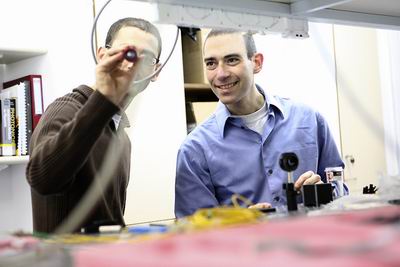Devices with nanometer dimensions allow us to mobilize light for many and varied purposes - starting with the production of electricity from solar energy and ending with the detection of impurities and the detection of counterfeits * The nanophotonics laboratory of Prof. Kobi Shoyer, in the Department of Electricity and Physical Electronics at the Faculty of Engineering, is developing a variety of fascinating applications for the innovative technology

"We deal with nanophotonics - the interaction of light with material particles in the nanometer dimensions," explains Prof. Shuyer. "It turns out that properties related to light, such as the color of the material, change significantly when it comes to tiny particles. For example, a solution containing gold particles that are 20 nm in size appears red to our eyes. The geometric shape of the particles also greatly influences the behavior of the nanoscale material. We study these materials and their properties, and find a wide variety of applications for them - more interesting, and even more interesting..."
Nanoantennas for receiving light waves
Among the important developments in Prof. Shoyer's laboratory, in collaboration with Prof. Yael Hanin and Prof. Amir Bog, can be found the nanoantennas - tiny antennas adjusted in size to the wavelengths of visible light. "In general, an antenna is a metal wire of a certain length, which receives electromagnetic waves of a suitable wavelength, and the electromagnetic waves create an electric current in the wire," says Prof. Shuyer. "The length of radio waves, for example, is measured in meters, and accordingly the size of the antennas. The wavelength of visible light, on the other hand, is in the nanometer range, and we are developing suitable nanoantennas that pick up the light waves."
The nanometer antennas, which are about half a micron to a micron in size, may be used for particularly efficient production of energy from sunlight. Thanks to their dimensions, they absorb a wide range of visible light waves and infrared light, therefore they are able to utilize a very significant part of the solar energy - up to 85%, compared to only about 30% in the technologies that exist today. A large array of such nanoantennas, spread over a large area, can produce a significant amount of 'green' electricity.
A nano-sensor for detecting explosives
Another direction of research by Prof. Shuyer and his team is the development of extremely sensitive nanosensors, which are able to detect the presence of a foreign substance, even when it is found in very small quantities. A nanometer sensor of this type is a light source - a laser with a very low sensitivity threshold, which changes its color under the influence of the material it is designed to detect. These sensors are expected to have many promising applications, such as detecting water contamination at the earliest stage, and detecting the minimal presence of explosives and chemical and biological toxins.
A gyroscope inside a pill
The gyroscope was invented in the 19th century, and was initially used - in its large, mechanical version - to maintain the stability of the compass in ships sailing the oceans. Later, the range of applications expanded greatly, and today gyroscopes are installed in airplanes, missiles, tanks, stunt motorcycles and even sophisticated cameras and cell phones. The researchers in Prof. Shoyer's laboratory, in collaboration with Prof. Benny Steinberg's group from the Faculty of Engineering, are working on the development of a tiny and highly accurate optical gyroscope, which will allow navigation - not necessarily in the air or across the oceans - but, for example, inside the human body. The nanometer gyroscope will be implanted inside a pill, and will direct the medicine directly to the place that needs it in the patient's body.
Tiny structures to prevent counterfeiting
Tiny, simple and cheap structures, the result of another project of the research group, may be used in the future to prevent counterfeiting - of banknotes, medicines and more. The nanometer structures, which cannot be seen with the naked eye, will be glued to the original banknote or product, and will be identified using a suitable optical device. A certain reaction of the nanometer structures to the light beam will confirm that the product is indeed real, and that the seal has not expired.
Prof. Kobi Shuyer from the School of Electrical Engineering at Tel Aviv University is a leading scientist in the field of micro-optics and nano-optics. The research areas in which he deals are sensors, renewable energy and optical communication. Prof. Shoyer is a core member and representative of the Faculty of Engineering in the scientific committee of the center for nanotechnology at the university. He published over 60 articles and books, and registered more than 10 patents.
